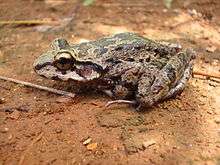Thoropa
Thoropa is a genus of frogs in the family Cycloramphidae.[1][2] They are endemic to eastern and southeastern Brazil. They are sometimes known as river frogs.[1]
| Thoropa | |
|---|---|
 | |
| Thoropa miliaris | |
| Scientific classification | |
| Kingdom: | Animalia |
| Phylum: | Chordata |
| Class: | Amphibia |
| Order: | Anura |
| Family: | Cycloramphidae |
| Genus: | Thoropa Cope, 1865 |
| Type species | |
| Cystignathus missiessii Eydoux and Souleyet, 1842 | |
| Species | |
|
6 species (see text) | |
Description, ecology, and behavior
Thoropa are associated with rocks and have cryptic coloration. Their size ranges from small to medium, 28–102 mm (1.1–4.0 in) in snout–vent length.[3] They occur at elevations up to 1,500 m (4,900 ft) above sea level;[3] Thoropa miliaris and Thoropa taophora can even live on rocky marine shores, foraging in the intertidal zone.[4][5] Male Thoropa are associated with wet rock faces, whereas the females seem to range more widely.[6]
In species where reproduction is known, males are territorial—suitable wet rock faces are a scarce resource. Furthermore, mature male Thoropa feature characteristic clusters of dark spines on the inner portions of the hand. It appears that these are associated with male-male combat, probably in conjunction with territorial disputes. Scratch marks in males, but not in females, support this interpretation.[6]
The eggs are laid on rocks with a thin layer of water. Tadpoles are semiterrestrial and have a depressed shape, long tail, and bulging eyes.[3]
Male T. taophora frogs mate exclusively and repeatedly with two females per season in a polygynous system in which the semiterrestrial tadpoles from both females share the same freshwater seep.[7] The females have a dominance hierarchy, and the males mate more with the dominant female.[7]
Species
The genus contains the following species:[1][2]
- Thoropa lutzi Cochran, 1938
- Thoropa megatympanum Caramaschi and Sazima, 1984
- Thoropa miliaris (Spix, 1824)
- Thoropa petropolitana (Wandolleck, 1907)
- Thoropa saxatilis Cocroft and Heyer, 1988
- Thoropa taophora (Miranda-Ribeiro, 1923)
References
- Frost, Darrel R. (2018). "Thoropa Cope, 1865". Amphibian Species of the World: an Online Reference. Version 6.0. American Museum of Natural History. Retrieved 12 October 2018.
- "Cycloramphidae". AmphibiaWeb: Information on amphibian biology and conservation. [web application]. Berkeley, California: AmphibiaWeb. 2018. Retrieved 12 October 2018.
- Nunes-de-Almeida, Carlos Henrique Luz (2015). Phylogenetic reconstruction based on internal and external morphology of the genus Thoropa Cope, 1865 (Anura, Cycloramphidae) (Master thesis). Universidade Estadual de Campinas.
- Abe, A. S. & Bicudo, J. E. P. W. (1991). "Adaptations to salinity and osmoregulation in the frog Thoropa miliaris (Amphibia, Leptodactylidae)". Zoologischer Anzeiger. 227: 313–318. hdl:11449/117830.
- Brasileiro, Cinthia A.; Martins, Marcio & Sazima, Ivan (2010). "Feeding ecology of Thoropa taophora (Anura: Cycloramphidae) on a rocky seashore in southeastern Brazil" (PDF). South American Journal of Herpetology. 5 (3): 181–188. doi:10.2994/057.005.0303.
- Cocroft, R. B. & Heyer, W. R. (1988). "Notes on the frog genus Thoropa (Amphibia: Leptodactylidae) with a description of a new species (Thoropa saxatilis)". Proceedings of the Biological Society of Washington. 101: 209–220.
- de Sá, F.P.; Consolmagno, R.C.; Muralidhar, P.; Brasileiro, C.A.; Zamudio, K.R.; Haddad, C.F.B. (2020). "Unexpected reproductive fidelity in a polygynous frog". Science Advances. 6 (33): eaay1539. doi:10.1126/sciadv.aay1539.